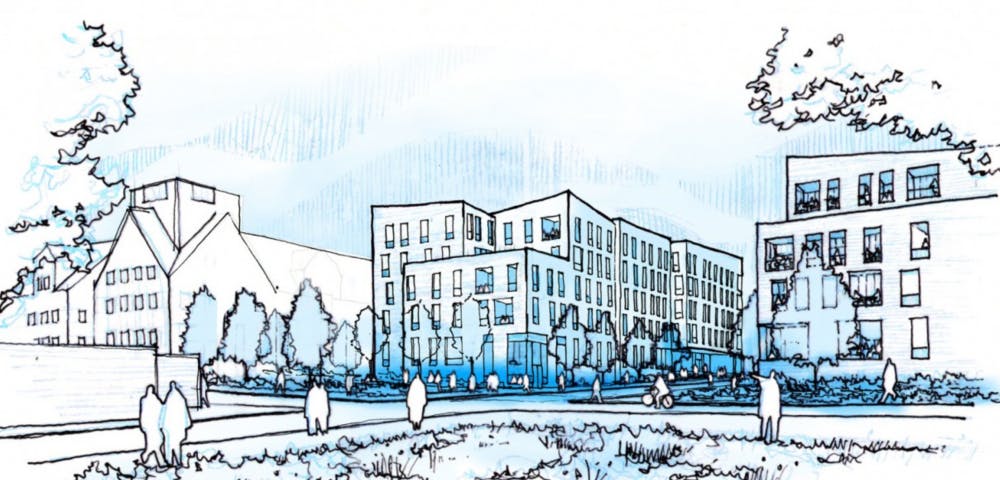The University recently rejected a set of four requests regarding the planned dorm on Brook Street made by various community groups and stakeholders.
A letter to University leaders and an accompanying petition asked for a reduction in height, preservation of historical buildings, preservation of retail space and for the design to be “compatible and in harmony with neighborhood architecture,” The Herald previously reported.
But in a June 29 letter to President Christina Paxson P’19 that was later shared publicly, Ward 1 Councilman John Goncalves ’13 MA ’15, one of the contributors to the original letter, wrote that the University rejected all four requests, despite the fact that the petition garnered nearly 1,000 signatures from community members.
If the construction proceeds as planned, retail space currently occupied by Bagel Gourmet, East Side Mini Mart and the Providence Police substation would be removed in favor of a green space. Additionally, the homes at 66-68 and 70-72 Charlesfield Street and 245 Brook Street would be torn down.
Nick Cicchitelli, president of the Fox Point Neighborhood Association, described his reaction to the University’s rejection of the requests as “extreme disappointment.”
Goncalves also told The Herald that he was disappointed, and that his feelings “channel the hundreds of constituents that I have talked to … I think that they’re disappointed, and Brown completely resented what the neighborhood has to say.”
“Of the four requests that were laid out, we were under the impression that (the University) would try to accommodate at least one or two of them,” Goncalves added. “The fact that they flat out rejected all four of them was very telling.”
“We made it as easy as possible … we boiled it down to four concerns that all of us agreed on,” Cicchitelli said.
The University has made “a number of significant revisions” to the dorm, according to University Spokesperson Brian Clark. In an email to The Herald, he wrote that the height of the building had already been reduced from five stories to three, and that the University has “worked diligently to support the relocation of the three residential houses, partnering with local community organizations and elected officials.” The University has also offered $75,000 per house to go toward potential relocation costs.
Still, Goncalves maintained that the changes were not sufficient. “There’s a difference between presenting a plan and incorporating community feedback,” Goncalves said. He speculated that the University “perceives its presentations to the community as meaningful community engagement, but if they’re not going to incorporate any feedback folks provide, then it’s not meaningful.”
Clark wrote that members have had the opportunity to provide feedback on the proposal through “13 public meetings, which included options to submit written feedback, verbal feedback and ask questions of Brown staff and project architects.” He added that while the community is discussing one recent set of demands, the University has worked extensively over the last year to collect and address community input.
In the letter to the University, Goncalves noted that while the community appreciated the various meetings, many view the University as having “undermined its commitment to meaningful engagement with neighbors and community organizations, given the fact that it was unwilling to revise its plans to reflect the desires of over a thousand community members and neighborhood residents.”
Goncalves said there is “absolutely” a consensus in community agreement on the petition. “They were very reasonable requests,” he said, “and we had over a thousand people sign on, so it goes to show you that people want to see (the University) be a better neighbor when it comes to these development projects.”
Clark acknowledged in his email that “the extensive revisions made in response to feedback and the University’s efforts to relocate the houses will not be seen as sufficient by all neighbors, and that a preferred outcome for some might be a dramatically smaller residence hall or no residence hall.”
Clark added that the retail space was removed to accommodate enough beds, given the community demands for a height reduction.
“I’m not opposed to moving 350 students back onto campus. We’re very supportive of that,” Goncalves said, citing housing in Providence as a prime motivation for the need for a new dorm. “We want to alleviate pressure from the residential neighborhoods, which has been a challenge for many years.”
But Cicchitelli countered Clark’s characterization of the removal of retail space as an indirect result of community feedback. “It feels disingenuous on Brown’s part to say (the removal of retail space) was in response to the community, when the vast majority want it to remain.” He said there is overwhelming support to keep retail space on the first floor, citing how important the mini mart is to the local community.
Regarding design, Cicchitelli said that the structure would not fit with the rest of the neighborhood. “If you look at the neighborhood, there’s five or six types of roofs. This design screams 2021, and I’m afraid that by 2040, it won’t make any sense with the surrounding buildings.”
Cicchitelli added that “we want to at least have a seat at the table and have some of our opinions considered … (The University) has said that they want to be good community partners. This is a great opportunity to show us.”

ADVERTISEMENT




